#Beas Kund Trek map
Explore tagged Tumblr posts
Text
Beas Kund Trek: Distance, Time & Trail Vibes!
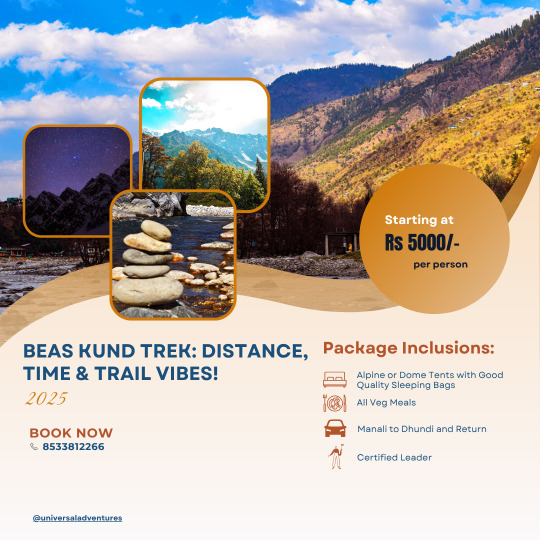
If you’re dreaming of a short yet breathtaking Himalayan adventure, the Beas Kund Trek is your perfect escape. 🏔️🌿
Nestled in the heart of Himachal Pradesh near Manali, this iconic trek takes you to the serene glacial lake known as Beas Kund, believed to be the origin of the mighty Beas River. 💧🏞️ Whether you’re a beginner or an experienced trekker, this journey through lush meadows, alpine terrain, and snow-capped peaks offers the ideal mix of beauty and challenge. ⛰️🌼 In this article, we explore everything you need to know—Beas Kund Trek distance, duration, map details, and the best time to visit Beas Kund Trek. 📍🗺️
Beas Kund Trek Distance is Just 16 KM of Pure Bliss! 🚶♀️🌬️
Let’s begin with one of the most commonly asked questions:
What is the Beas Kund Trek Distance?
The total trekking distance is around 16 kilometers, making it one of the most accessible high-altitude treks in Himachal. 📏🏕️ The trail typically starts from Solang Valley and takes 3 days to complete, depending on your pace and acclimatization. ⏳🧗♂️ With a moderate difficulty level, it’s suitable for fit beginners and families with older children. 👨👩👧👦🌲
The Beas Kund Trek map shows a gradual elevation gain from 8,000 ft to 12,772 ft. 📈 The key stops include Solang Valley – Dhundi – Bakarthach – Beas Kund, offering a slow but scenic climb that gives you time to adjust to the altitude. 🏞️🧭
Trail Vibes: What to Expect on the Trek 🌿👣
The Beas Kund Trek offers stunning trail vibes that change dramatically as you ascend. 🎨 Starting from Solang, the trail takes you through deep green forests, vibrant alpine meadows, and rocky paths with mountain views. 🌲🌸🪨 You’ll witness the impressive peaks of Hanuman Tibba, Friendship Peak, and Shitidhar standing tall along the trail. 🏔️🧊
The real magic begins once you reach Beas Kund, a peaceful lake surrounded by snow-laden peaks and silence broken only by the soft flow of glacial water. 🧘♀️💦 This is the place where Rishi Vyas, the author of the Mahabharata, is believed to have meditated. 📖🙏 It’s not just a trek—it’s a spiritual and natural experience rolled into one. 🌌✨
Beas Kund Trek Best Time to Visit 📅☀️
The Beas Kund trek best time to visit is from mid-May to mid-October. 🗓️ During this period, the trail is clear of snow and the weather is generally pleasant. ☁️🌤️
May to June: Meadows are lush green, flowers bloom everywhere, and snow still blankets the higher peaks. 🌼⛅
July to August: The monsoon hits, making the trail slippery and less ideal for trekking. 🌧️⚠️
September to October: This is one of the best windows—clear skies, crisp air, and golden landscapes as autumn sets in. 🍁🧣
Avoid the peak winter months (November to April) as the area becomes inaccessible due to heavy snowfall and extreme temperatures. ❄️🚫
Let the Beas Kund Trek Map Guide You to Himalayan Bliss 🗺️🕊️
The Beas Kund Trek is a perfect introduction to Himalayan trekking. 🎒�� With its manageable 16 km trek distance, ever-changing scenic vibes, and a rich mythological background, it delivers an experience that stays with you long after you return. 🏞️💭 Remember to check your Beas Kund Trek map, plan according to the best time to visit, and pack appropriately for the changing weather. 🎯🎒
So, pack your boots and hit the trail—it’s time to let the wild and the wonders of Beas Kund refresh your soul! 🌬️🌄💖
#Beas Kund#Beas Kund Trek Distance#Beas Kund Trek#Beas Kund trek best time to visit#Beas Kund Trek map
0 notes
Text
Top Reasons to Choose Beas Kund Trek: A Beginner's Guide to Himachal's Beauty
Chasing Legends to the Source: Will Beas Kund Reveal Its Mystique?
Are you seeking a trek that blends raw Himalayan beauty with mythical history? Then this journey will speak to your soul. Located in the lap of the Dhauladhar range, Beas Kund Manali isn't just a trekking destination—it’s a living tale told through trails, rivers, and snowy landscapes. It's where you chase ancient legends right to their icy origin. Let’s dive into this magical escape!
Beas Manali: Where Urban Vibes Meet Mountain Calm
The town of Beas Manali is where most adventurers begin their journey. With bustling markets, cozy cafés, and a constant backdrop of snow-laden peaks, it serves as the perfect basecamp for your high-altitude adventure. Whether you’re picking up last-minute supplies or simply soaking in the scenery, this town is more than a stop—it’s an experience. From here, the contrast is sharp. As you leave the comforts of Manali and step into the pristine wilderness of the trek, each step feels like you’re shedding the noise and entering a realm untouched by time.
Beas River: The Life Source of the Valley
Reaching the source of the Beas River is like meeting an old friend for the first time. You’ve followed it through towns, seen it in postcards, perhaps even crossed it on a bridge—but now, standing at its icy origin, it feels personal. The glacial lake that gives birth to this powerful river is small but deep in mystery. It’s a silent place. No murmur of crowds, just the occasional flap of a tent or crunch of boots on snow. The surroundings are surreal—green meadows stretch till your eyes hit the white wall of glaciers. This is the moment where adventure and awe collide.
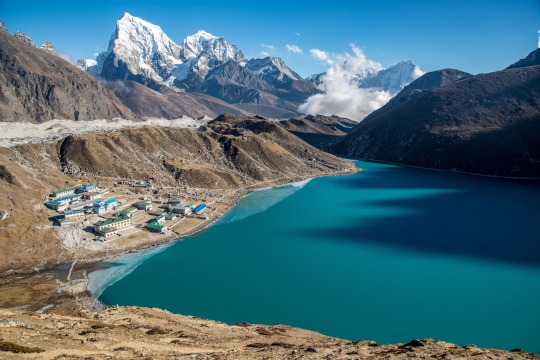
Beas Kund Trek Map: Your Compass Through the Clouds
When you're out chasing clouds and legends, a Beas Kund trek map is more than just a tool—it’s your story outline. The trail begins from Dhundi and passes through Bakarthach, a meadow nestled in serenity. From there, the climb becomes slightly more intense as you approach Beas Kund, surrounded by towering peaks. The route, though moderate in difficulty, takes you through a wide range of landscapes: pine forests, rock patches, glacial streams, and open valleys. A map not only helps you track distance but also appreciate how much elevation you’ve gained—both physically and emotionally. Every marked point on the map represents a milestone of endurance and discovery.
Conclusion: So, Does Beas Kund Reveal Its Mystique?
The mystique of the Beas Kund trek doesn’t lie in dramatic tales or jaw-dropping heights. It lies in the journey. In each footstep on the trail. In the way the air feels thinner and purer as you ascend. In the moment you see the glacial lake for the first time and feel completely present. Beas Kund doesn’t reveal all its secrets. It lets you find your own. Whether you're drawn by legends, adventure, or the sheer peace of the mountains, the Beas Kund trek is ready to welcome you. Just lace up your boots, follow the river, and let the Himalayas unfold their timeless story.
0 notes
Text
How Long is the Beas Kund Adventure?

The Beas River Manali is more than just a scenic beauty; it’s an invitation to adventure. Originating from the majestic Beas Kund lake, nestled at a high-altitude of 3,810 meters, this river flows through the heart of Manali, painting landscapes with refreshing vibrancy and serenity. The Beas Kund Trek, a popular escapade for thrill-seekers and nature enthusiasts alike, offers a journey that winds through the mesmerizing Solang Valley, unveiling breathtaking meadows, and awe-inspiring peaks like Hanuman Tibba, Friendship Peak, and Seven Sisters. As the river Beas flows gracefully through these spectacular sights, the journey transforms into an unforgettable adventure. If you’re planning a getaway that combines physical challenge with stunning natural beauty, this trek is a must on your travel list.
The Beas River Manali Trek: An Adventure through Nature’s Best
The Beas River Manali trek is an immersive experience that captures the raw beauty of the Himalayas. Trekking along the Beas River, you’ll witness some remarkable spots, including:
Enchanting Places on the Beas River Trail
The Beas River meanders gracefully through Solang Valley, providing a refreshing and serene journey through lush landscapes. The Beas Kund Trek trail opens up into the vibrant meadows of Dhundhi and Bakarthach, where trekkers can soak in the unspoiled charm of the valley.
Throughout the trek, breathtaking mountain vistas await, including prominent peaks like Hanuman Tibba, Friendship Peak, Shitidhar, and Seven Sisters. Each peak stands majestically against the sky, creating a surreal backdrop as you make your way to Beas Kund.
Beas Kund itself lies at the heart of the Kullu Valley, offering panoramic views of the Pir Panjal range and other snow-capped peaks. This sacred lake, believed to be the origin of the Beas River, holds deep spiritual significance. Ancient lore tells that the sage Vyas, who authored the Hindu epic Mahabharata, meditated here, making Beas Kund a place of both natural and spiritual beauty.
Beas Kund Trek best time to visit
The Beas Kund Trek best time to visit is between May to October. During these months, the snow melts, revealing the lush meadows and vibrant flora of the region, making the trek more accessible. In spring and summer, temperatures range from 10°C to 20°C, offering a comfortable climate for trekking. However, the monsoon brings occasional rains, which can enhance the landscape’s charm but also calls for waterproof gear.
Understanding the Beas Temperature: A Cool Mountain Climate
The average Beas temperature remains moderate, ranging from 10°C to 20°C during trekking season. Mornings and evenings are cooler, especially at higher altitudes, making it essential to carry warm clothing. The pristine mountain air, combined with refreshing breezes, provides a perfect balance for a challenging trek.
Beas River Manali Booking: Planning Your Trekking Adventure
For those looking to make the most out of their Beas Kund experience, here are some travel packages with different starting points.
Trekking from Solang Valley
Duration: 3 Days, 2 Nights
Cost: ₹ 4,499 per person
Trekking from Manali
Duration: 3 Days, 2 Nights
Cost: ₹ 5,499 per person
Trekking from Delhi
Duration: 3 Days, 2 Nights
Cost: ₹ 6,999 per person

Essential Tips and Packing List: Beas Kund Things to Carry
To make your Beas Kund adventure safe and enjoyable, here are some essential items to include in your backpack:
Warm Clothing: The temperature drops significantly at night and at higher altitudes, so layering is essential.
Waterproof Jacket and Pants: Sudden rain showers are common.
Sturdy Trekking Boots: For better grip on rugged terrain.
Lightweight Tent and Sleeping Bag: If you’re planning an extended trip.
First Aid Kit and Essential Medicines: For emergencies.
Sunscreen, Sunglasses, and Hat: To protect against the intense sun at higher altitudes.
Water Bottles and Snacks: Energy bars, nuts, and dry fruits to maintain energy levels.
Map of Beas River Region: Having a physical map can help you understand the trek layout and avoid getting lost.
Equipped with these essentials, you’ll be ready to enjoy an extraordinary trek to Beas Kund.
While embarking on this adventure, a Beas River map proves invaluable, detailing the trekking route from Solang Valley through Dhundhi and Bakarthach and up to the pristine lake of Beas Kund. The map is helpful in identifying various points of interest, scenic spots, and major landmarks, making it easier to appreciate the beauty of the area while staying on track.
Conclusion
The Beas Kund Trek encapsulates the serene beauty of the Himalayas, the spiritual significance of Beas Kund, and the thrill of trekking along the Beas River in Manali. With its lush valleys, majestic peaks, and panoramic views, this trek offers an unmatched experience for nature lovers and adventure seekers alike. Embark on this journey to discover the soul-stirring beauty of Manali’s landscapes, where every turn brings a new wonder, and every step takes you closer to the divine beauty of the Beas River.
0 notes
Text
Beas Kund Trek Manali 2025
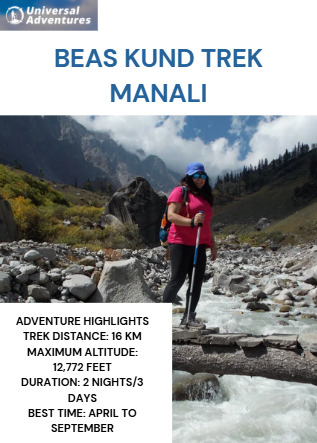
Beas Kund Trek Map + Best Season = Perfect Trip!
The Beas Kund Trek is one of the most picturesque and rewarding treks near Manali, Himachal Pradesh. Nestled amidst the towering peaks of the Himalayas, this trek offers adventurers a perfect blend of natural beauty, spiritual vibes, and moderate challenge. If you’re planning to explore the mystic valleys of the Beas river basin, understanding the Beas Kund trek map and knowing the best season to visit can make all the difference to your trip.
Understanding the Beas Kund Trek Map
The Beas Kund trek map outlines a 16 km journey starting from Dhundi near Solang Valley, which sits at an altitude of approximately 8,156 feet. The trail moves through enchanting forests, crystal-clear streams, and lush meadows to reach the holy lake called Beas Kund, situated at 12,772 feet between the majestic peaks of Hanuman Tibba and the Seven Sisters.
The route begins with a scenic drive from Manali to Dhundi, followed by an easy to moderate trek first to Bakar Thach, a beautiful camping site surrounded by alpine meadows. From Bakar Thach, trekkers ascend to Beas Kund Lake on the second day, enjoying panoramic views of the surrounding peaks and the legendary Beas River's source. The last day involves retracing your steps back to Dhundi and driving to Manali.
The detailed Beas Kund trek map is essential for understanding the terrain, altitude changes, and resting points, helping trekkers prepare mentally and physically for the adventure.
Best Time to Visit: Beas Kund Trek Best Time to Visit
Choosing the Beas Kund trek best time to visit is crucial for a comfortable and enjoyable experience. The ideal window to embark on this trek is from April to September. During these months, the snow has mostly melted, the weather is mild, and the trail is clear, making it safer and more scenic.
April and May bring blooming wildflowers and fresh greenery, while June to September is great for pleasant temperatures and clearer skies. The monsoon season (July-August) might bring occasional showers, but the trail is generally still manageable.
Winter months are usually harsh with heavy snowfall, making trekking difficult and unsafe without proper gear and experience.
Beas Kund Temperature and Weather Conditions
The Beas Kund temperature varies significantly depending on the altitude and season. At the base near Manali, temperatures in summer range between 15°C to 25°C, ideal for trekking and outdoor activities. However, as you ascend towards Beas Kund, the temperature can drop drastically, especially during early mornings and nights, sometimes falling below 0°C.
Understanding the Beas Kund weather helps trekkers pack appropriately with warm clothing, waterproof jackets, and proper trekking gear to handle cold nights and variable weather conditions during the trek.
Exploring the Scenic Beas River and Surroundings
The Beas River, originating near Beas Kund, flows majestically through the valleys, creating stunning landscapes along the route. The Beas River and its tributaries are integral parts of this trekking experience, offering soothing sounds of flowing water and picturesque spots for rest and photography. Along the trail, you’ll also find the smaller river, fed by glacial melt, which adds to the pristine environment. The proximity to the river enhances the overall trekking experience, connecting you closely with nature.
What Makes the Beas Kund Trek Special?
Being close to Manali, the Beas Kund trek is accessible yet rewarding. Manali serves as the perfect base with its tourist facilities, accommodation options, and easy transportation links. The trek offers a great escape from city life with its fresh mountain air, peaceful surroundings, and panoramic views of the Himalayas.
The moderate trek length and altitude make it suitable for beginners and experienced trekkers alike, making the Beas Kund trek a popular choice among adventure seekers.
Know the Beas Kund Trek Distance and Duration
The total Beas Kund trek distance is approximately 16 km, covered over 2 nights and 3 days. The first day involves a trek to Bakar Thach, the second day is a longer hike to the Beas Kund lake and back, and the final day includes the return trek to Dhundi. This manageable distance allows trekkers to enjoy the natural beauty at a relaxed pace while experiencing different altitudes and landscapes each day.
The Beas Kund trek promises an unforgettable Himalayan adventure filled with serene lakes, scenic trails, and the majestic presence of the Beas River. Plan your trip during the best time to visit, study the trek map, and prepare for varying Beas Kund temperatures to make your trek safe, enjoyable, and memorable.
1 note
·
View note
Text
Beas Kund Trek Distance: How Difficult Is It for Trekkers?

The Beas Kund Trek is one of the most scenic and exciting treks in the Beas Manali region, offering breathtaking views of the Pir Panjal range. This trek takes you to the glacial lake Beas Kund, which is the source of the Beas River. It is an excellent choice for beginners as well as experienced trekkers who want to experience the beauty of the Himalayas without a highly demanding trek.
In this article, we will explore the Beas Kund Trek distance, its difficulty level, the Beas Kund Trek map, and the best time to visit Beas Kund Trek.
Beas Kund Trek Distance and Route Map
The Beas Kund Trek distance is approximately 16 km round trip, making it a relatively short but rewarding trek. The journey starts from Solang Valley, a famous adventure hub near Manali.
The trail follows a well-marked path, with gradual ascents and breathtaking views of the Beas Kund Manali region.
Here is a breakdown of the route, as seen on the Beas Kund Trek map:
Solang Valley to Dhundi (8 km) — This part of the trek is relatively easy, with lush green meadows and small water streams.
Dhundi to Bakarthach (5 km) — The terrain becomes rockier, and the incline increases, requiring some stamina.
Bakarthach to Beas Kund (4 km) — The final stretch to the glacier lake is slightly challenging but offers mesmerizing views of snow-capped peaks.
Most trekkers complete the trek within 2 to 3 days, depending on the weather and pace. If you are well-prepared, it can also be done in a single day.
Beas Kund Trek Difficulty Level
Is Beas Kund Trek Difficult? A Guide With Beas Kund Trek Map
The Beas Kund Manali trek is classified as an easy to moderate trek. While it does not require technical climbing skills, some aspects can be challenging for beginners. Understanding the Beas Kund Trek difficulty level and referring to the Beas Kund Trek map can help trekkers prepare for the journey.
Factors Affecting Difficulty
Altitude Gain — The trek takes you to an altitude of 12,772 feet (3,892 meters), which can cause mild altitude sickness for some trekkers.
Terrain — The initial trail is easy, but the later sections have rocky paths, making balance and careful footing essential.
Weather Conditions — Temperatures can drop significantly, especially at night, making proper clothing essential.
If you are physically fit and have some basic trekking experience, this trek should be manageable. Beginners should prepare with basic cardio and leg-strengthening exercises before attempting it.
Beas Kund Trek Best Time to Visit
The Beas Kund Trek best time to visit depends on the kind of experience you are looking for. Here’s a breakdown of different seasons:
1. Summer (May–June)
This is the ideal season to visit as the weather is pleasant, with clear blue skies and lush green meadows.
The snow has mostly melted, making the trail more accessible.
2. Post-Monsoon (September–October)
The landscape turns golden, offering stunning views of the surrounding mountains.
The weather is slightly colder but remains stable for trekking.
3. Monsoon (July–August) — Not Recommended
Heavy rainfall can make the trails slippery and increase the risk of landslides.
Streams along the route can overflow, making crossings difficult.
4. Winter (November–April) — Only for Experienced Trekkers
The trail is covered in snow, making it challenging and requiring special gear.
The Beas Kund lake often freezes, offering a surreal but extreme trekking experience.
For most trekkers, May–June and September–October are the best months to visit.
Things to Carry for Beas Kund Trek
If you are planning the Beas Kund Manali trek, here’s a list of essential items to carry:
Clothing — Warm layers, gloves, and a waterproof jacket.
Footwear — Good trekking shoes with a firm grip.
Backpack — A lightweight yet spacious backpack.
Food & Water — Energy bars, dry fruits, and at least 2 litres of water.
First Aid Kit — Bandages, painkillers, and altitude sickness medicine.
Trekking Gear — Trekking poles and sunglasses for snow glare.
Explore the Beauty of Beas Kund Manali: A Perfect Trek for Adventure Seekers
The Beas Kund Trek is an amazing adventure for nature lovers and trekkers who want to experience the beauty of the Beas Manali region. With a moderate trekking distance, manageable difficulty level, and breathtaking views, this trek is ideal for those seeking a short yet fulfilling Himalayan experience.
To make the most of your trek, plan your journey during the Beas Kund Trek best time to visit and ensure you are well-prepared. Whether you are a beginner or an experienced trekker, the Beas Kund Trek map offers a well-marked route to one of the most stunning glacial lakes in India.
So, are you ready for this unforgettable adventure? Pack your bags and explore the mesmerizing beauty of Beas Kund Manali!
0 notes
Text
Top 10 best treks in Himachal Pradesh
Himachal Pradesh is situated in the north of India and is a wonderful destination for nature lovers and adventurers. With snow-capped mountains, green valleys, beautiful lakes, and beautiful towns, the state has something for everyone. It is home to the highest peaks in the Himalayas, such as Rohtang Pass, Pin Parvati Pass, and many more. Treks in Himachal Pradesh are a popular activity, and Pluto Tours provides opportunities to explore some of the most scenic and challenging trekking trails in the country. From the high-altitude deserts of Spiti and Kullu to the green forests of Kolkata and Manali, there is a trekking option for everyone, no matter your fitness level or experience level.
1. Triund Trek If you want to do solo trekking in Himachal then you should go to Triund trails and have a meeting with the mountains. Dhauladhar ranges look gigantic and beautiful. You can camp under the stars at night and have a fire. You will be happy to be in the middle of such beauty. There is no other place like Triund in the world. If you don’t believe us then go and see it for yourself.
Best time to visit: During the summer months because it’s easier to get out on the trail.
Duration:1–2 Days Difficulty: Easy
2. Hampta Pass Trek The name ‘Hampta Pass’ comes from the Hamta village situated in the region of Pir Panjal. At 14,000 feet, this pass is mainly traversed by Shepherds and a small number of trekkers. Hampta Pass is surrounded by glaciers, streams, steep mountains and meadows. It is one of the most difficult trekking routes in the state of Himachal Pradesh and you will not be able to go on this trek without using the HCP trekking map.
Best time to visit: During Monsoon Season Duration:5–6 Days Difficulty: Easy to Moderate
3. Kheerganga Trek The KheerGanga in Kasol is a frothy white mountain river that falls from high in the mountains. The only way to reach the Ganges is through a short but difficult trek. The Kheerganga trek is well-known all over the country and trekking enthusiasts rave about the beauty of this trek. The trek is approximately 12 km in length and can be completed in 5 to 6 hours if a few short breaks are taken.
Duration:1–2 Days Difficulty: Easy
4. Bhrigu Lake Trek Bhrigu Lake Trek is located at 14,000 feet and will give you the ultimate high. This is the only Himalayan trek that you can do in just 2 days. Due to the season of May-June being the best time for trekking in Himachal Pradesh, this is considered one of the top summer Best treks in Himachal Pradesh. This trek might be a bit intimidating for beginners as the trails are a bit steep.
Duration: 3 Days Difficulty: Easy to moderate
5. Kareri Lake Trek Kareri Lake Trek is located in the Kangra district of Himachal Pradesh. The trek is a great way to get away from the hectic and hectic life back home. Kareri Lake is a great trek to see the most beautiful and beautiful views of nature in all its glory. The trails are lined with Chir and Chilgoza Pines, and the trees, lake, camps, and open skies make it a paradise for nature lovers and photographers.
Duration:3 Days
Difficulty: Easy to moderate
6. Indrahar Pass Trek Indrahar Pass is one of the top trekking destinations in Himachal Pradesh where you will be able to get some amazing pictures of the beautiful Lahesh caves. You will also be able to get a panoramic view of the Himalayan peaks of Dhauladhar and the Himalayan peaks of Kangra. Indrahar Pass Trek is one of the most difficult treks in the state of Himachal Pradesh. The pass is located between the Kangra district and Chamba district. It has steep climbs and steep ascents.
Duration:4–5 Days Difficulty: Moderate to difficult
7. Beas Kund Trek
Beas Kund is located in the Dhauladhar range of the Himalayas. Beas Kund is not only one of the most beautiful places but also one of the most historical places. You have to do a short trek to reach Beas Kund. The trek is 15���17 km and can be completed in 3 days. This trek is suitable for people of all ages as it is not too difficult. You do not need to be an expert trekker to complete this trek. You can stay at campsites on the way and enjoy the beautiful scenery.
Duration:2 Days Difficulty: Easy
8. Chandrakhani Pass Trek
Chandrakhani Pass Trek offers a panoramic view of the Deo Tibba Range and the Pir Panjal Range. This trek ranges from 2,500 meters to 3,600 meters in altitude. It is among the moderate and low-altitude treks in the Himachal Pradesh hiking circuit. The trek begins from Naggar and passes through Rumsu, Ghanachalani and Celanti. Himachal Pradesh hiking is as good as it gets.
Duration:3 Days Difficulty: Easy
9. Prashar Lake Trek
Prashar Lake is encircled by the majestic Dhauladhar ranges in the Kullu Valley. This Himalayan trekking destination offers an amazing 180-degree panoramic view of the mighty Dhauladhari mountain ranges, which includes the famous Panjal mountain range and the Kinnaur range. There are two ways to get to Prashar Lake from Delhi. The first way is via Baggi village, and the second way is via the same route. The trek to Baggi village from Delhi is a bit challenging compared to the route to Prashar. It is the ideal winter snow trek in Delhi.
Duration:1–2 Days
Difficulty: Easy
10.Malana village trek Malana village trek starts from the village of Jari, Himachal Pradesh. It is a 4 km long trail that leads to one of India’s oldest villages. When you visit the hills, if there’s one thing you need to do, it’s take a long stroll on the narrow, winding paths that run through the heart of the mountains. If you’re planning a trek to Kasol, you’ll want to experience the excitement of walking from Kasol towards Malana. With the foggy morning and the fresh mountain air, it’ll clear your mind and make you feel refreshed. It’s one of the best treks in Himachal Pradesh.
Duration:2–3 Days Difficulty: Moderate
Conclusion: Himachal Pradesh is one of the best trekking destinations in the world due to its diverse terrain and rich heritage. From the snow-capped peaks of Rohtang Pass to the tranquil waters of Beas Kund, each trek tells a unique story of the beauty of nature. So put on your hiking boots and get ready for an adventure that transcends the every day — discover the untamed beauty of Himachal with the help of Pluto Tours.
0 notes
Text
Doing this trek today. Four days should be fun.
2 notes
·
View notes
Text
Advance Mountaineering Course - A. B. V. I. M. A. S. - Part 2
Continued from Advance Mountaineering Course - Part 1...
h. Height Gain & Survival Night:
(Day 21 - Day 23)
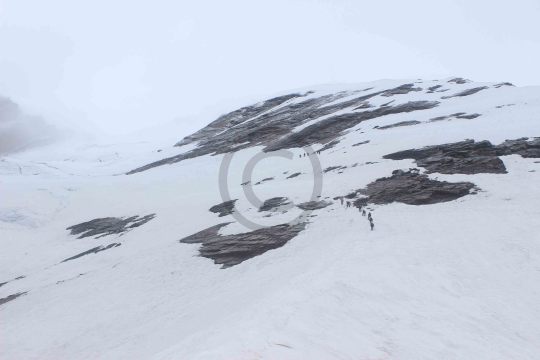
Height Gain is an activity where the trainees will be made to gain a sudden height of some thousand feet. This activity is used to test whether a trainee can remain stable physically and mentally at high altitudes after gaining sudden height. On the evening before height gain, all the trainees will be provided with dry ration for the activity. For this activity, the trainees will be taken to Friendship Peak (5289 m).
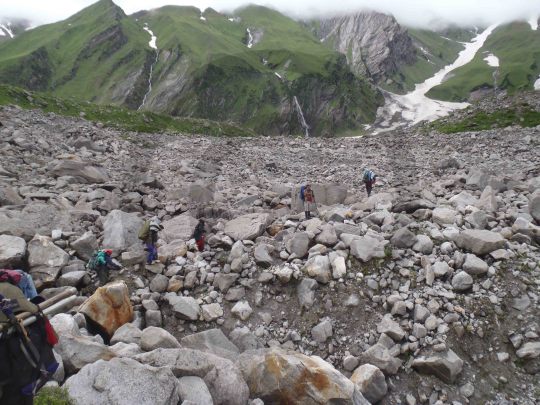
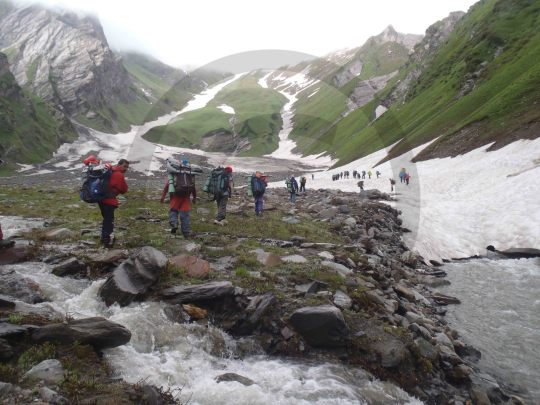
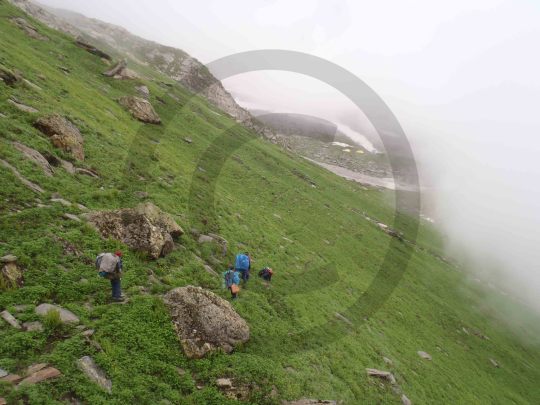
The height gain activity is conducted for two days. On the first day, trainees will move to advanced base camp, by early afternoon, near Lady Leg Ridge below the peak. Before moving to ABC, trainees will have to wind up the tents at base camp to be taken to ABC, collect equipment & ropes, and utensils & food ingredients. The climb towards ABC is a steep climb passing along Beas Kund and then crossing a gully to move towards Lady Leg Ridge. After reaching ABC, trainees will have to establish tents, and then will be divided into groups for spending the remaining time before the actual climb. The Instructors will give instructions regarding the ABC, where to refill water bottles, yellow area and so on.
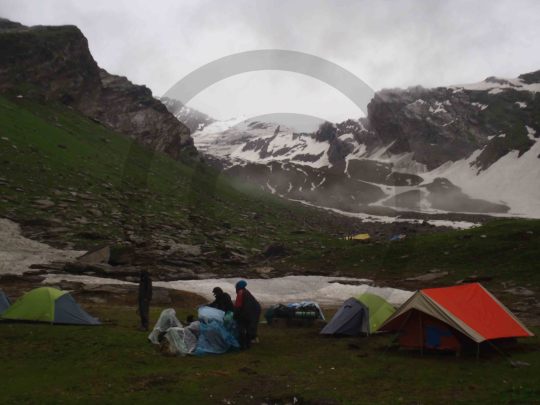
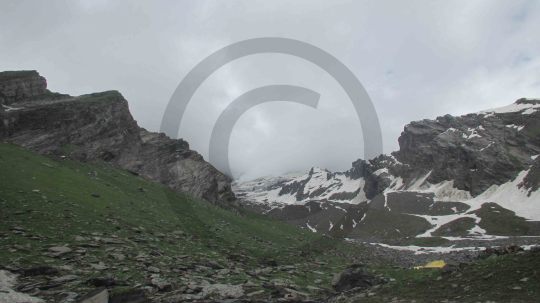
Later in evening, there will be a fall-in and the entire batch will be divided into climbing ropes and one of the ropes will open the route. Proper instructions will be given regarding the climb, what time to start the climb, the deadline time, and returning back to base camp. After the fall-in, trainees will be served with dinner. Post dinner, trainees will be given some time to rest in their respective tents. One should note that, this activity is called height gain because reaching the summit is subject to weather conditions, but reaching the qualifying height is compulsory. Hence, if a trainee is unable to reach the qualifying height, then the entire hard work of previous 20 days will be rendered useless i.e., a trainee will secure grades other than 'A' Grade. Trainees who wish to stay back and not go for the climb should inform the Instructors before-hand.
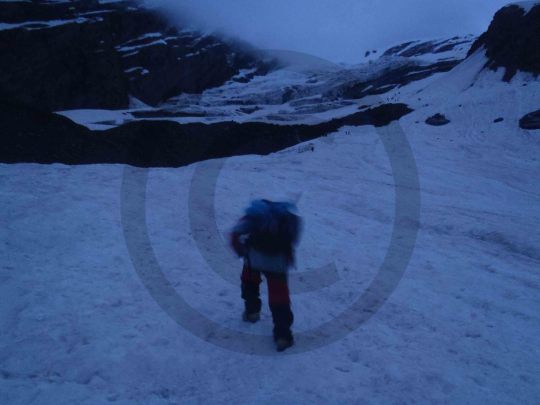
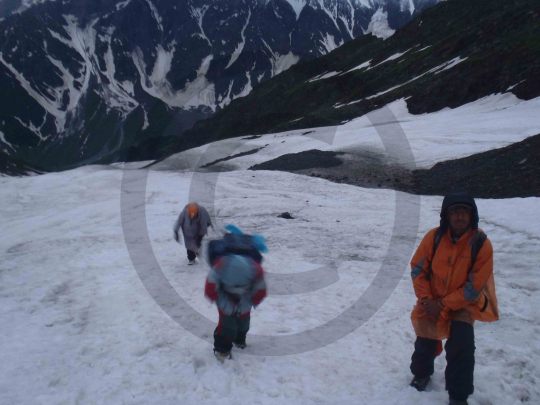
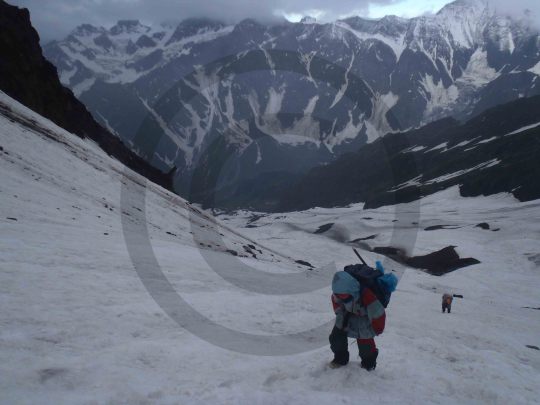
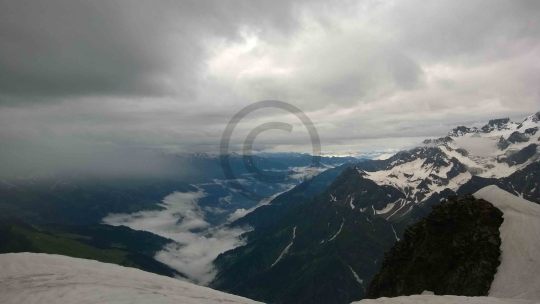
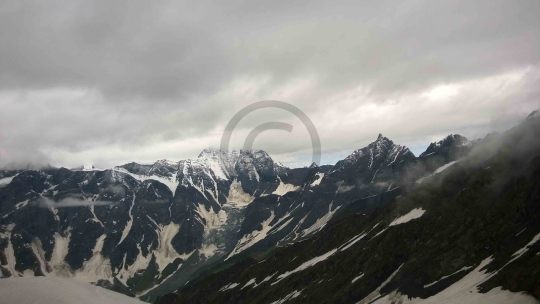
The climbing generally starts at 02:00 a.m., and hence trainees will have to be awake by midnight. Trainees are expected to pack their rucksack with all the necessary accessories before the climb and be ready with the climbing gears. Trainees will be served with tea and light breakfast, and after that there will a fall-in before the climb. The route opening rope will move far ahead of others, and then the other ropes will start climbing. The climb towards the summit is of varying steepness, along avalanche-prone area and glacial surface. The qualifying height is approximately at 17000 feet and is a narrow shoulder before the summit. If the weather conditions are good, the trainees will be taken to the summit of Friendship Peak. On reaching the summit, one can get a clear view of the Beas Kund Valley, surrounding peaks, Raigad Glacier, and peaks in the Pin Parvati Valley. Trainees who reach the qualifying height or summit will be noted by the Instructors. The descend will be quick as one can glissade long patches if the snow conditions are good. Depending in which season the course is conducted, the climbing conditions vary drastically from heavy snow conditions to one with full of crevasses.
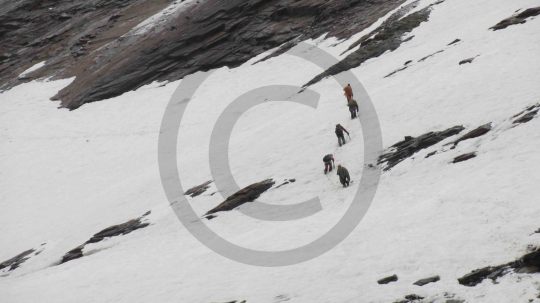
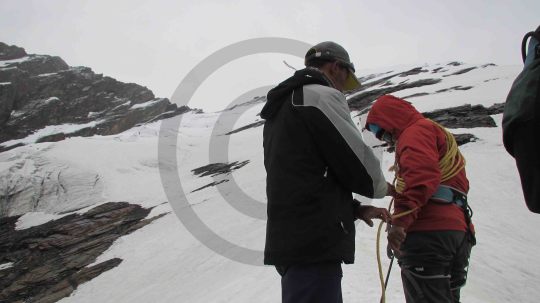
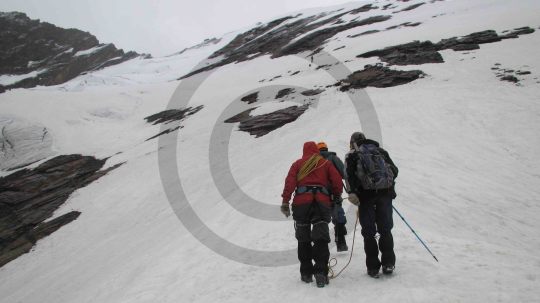
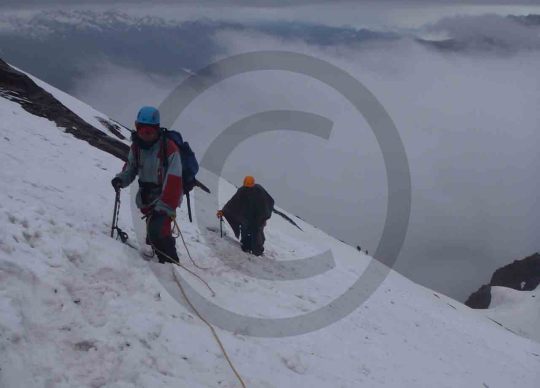
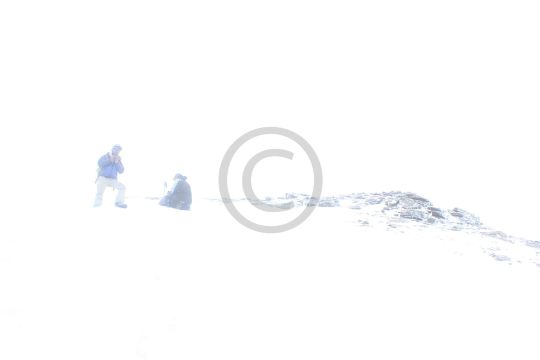
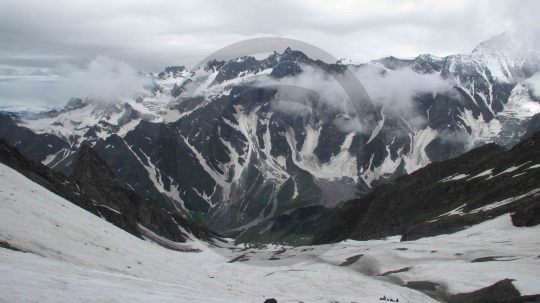
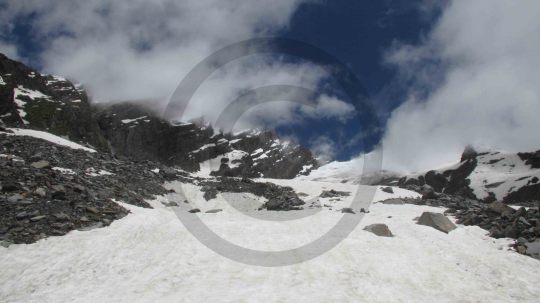
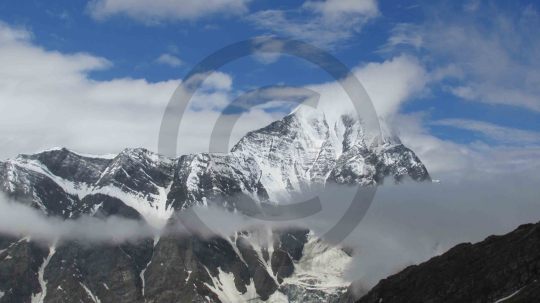
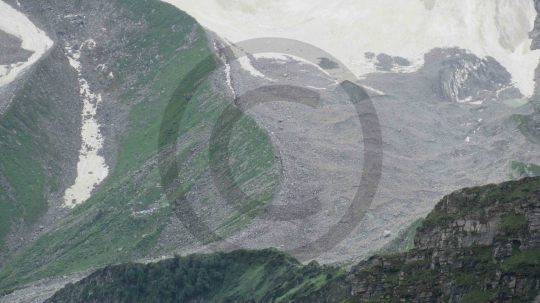
After reaching the ABC, trainees will have to wait there till all the trainees arrive. Trainees can spend some time to eat and rejuvenate before moving to the base camp. Before moving to the base camp, trainees will wind up the entire ABC and clean it. On reaching the base camp, trainees will have to set up their tents and keep all their climbing gears for drying. All the activities for AMC end after height gain with only survival night remaining.
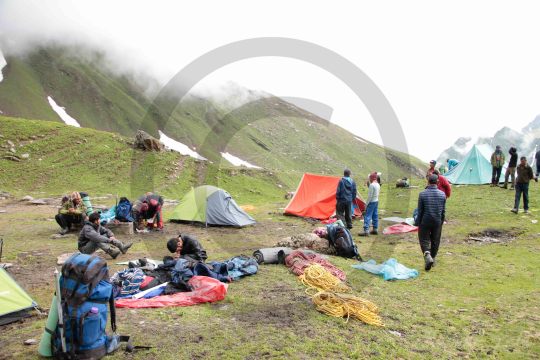
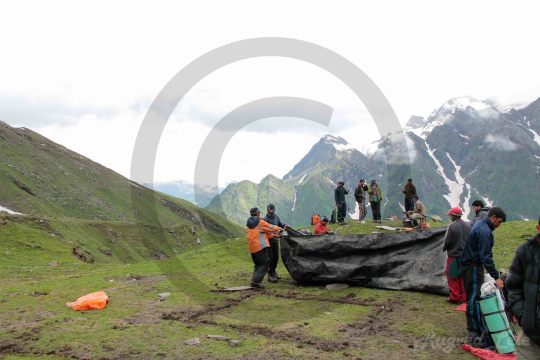
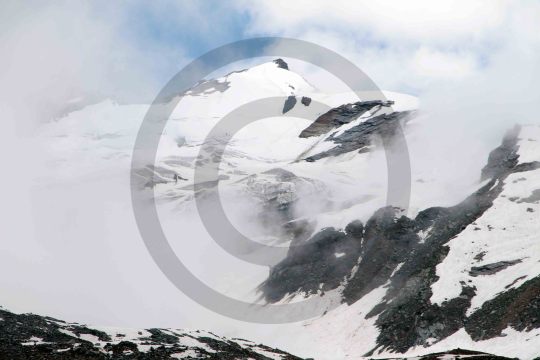
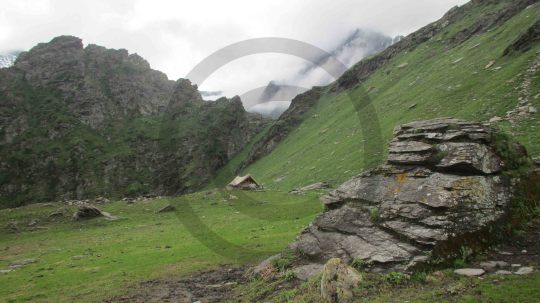
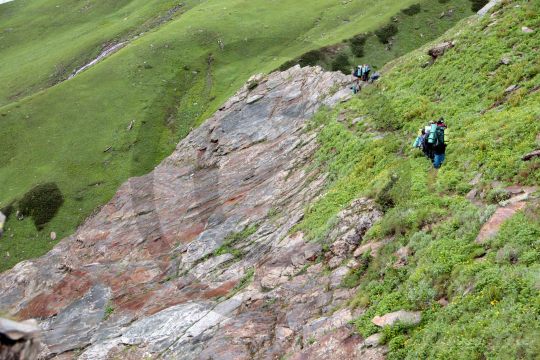
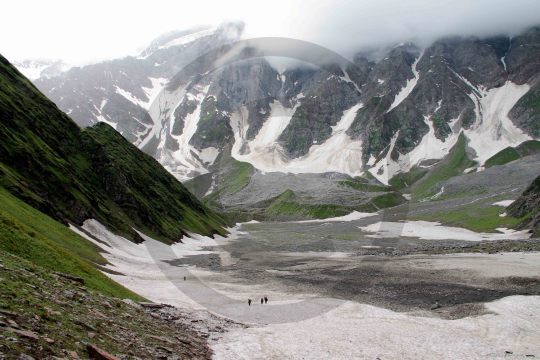
The next day will be "Adam's Day" and trainees will have no activities to do. They will have to wash all their climbing gears and dry them. In the evening, there would be some short lecture or demonstration or using Avalanche Beacons.
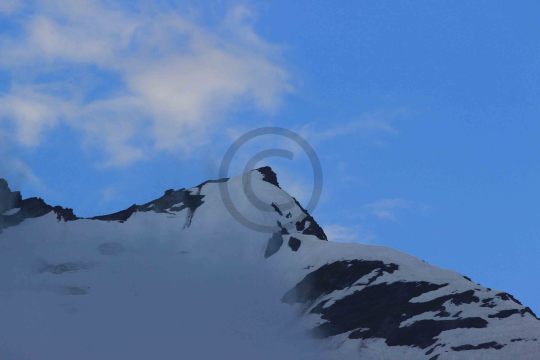
(Day 24)
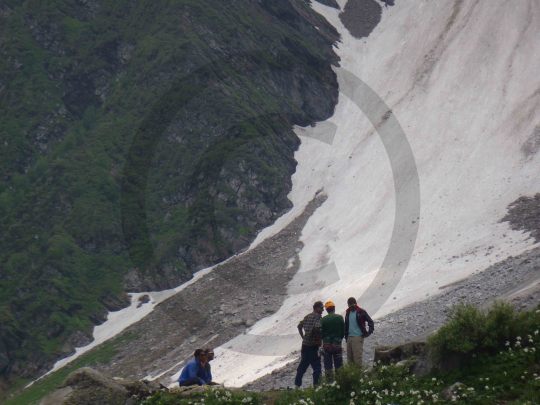
Test will be conducted in the morning and will cover many many aspects of the entire training. The test will be conducted Rope-wise and will involve vivas, knots and practical demonstrations. Post lunch, trainees will have to pack their entire rucksack and keep it ready for next to move towards Solang quickly. Bush Craft or other activities will be conducted based on various factors.
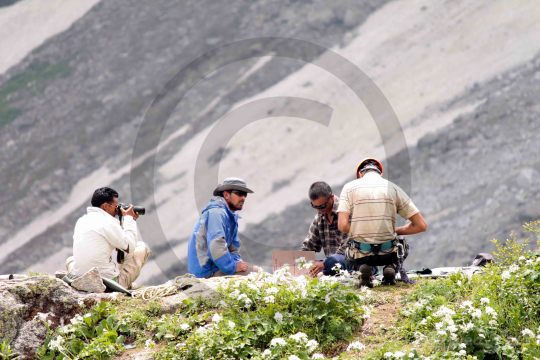
Bush Craft is an activity which teaches a mountaineer to follow signs and indications in the mountains if he / she gets lost, or is stranded, or the team gets divided due to some forceful conditions. Bush Craft will be conducted in the bushes near the base camp. In this activity, a Rope has to reach the target from the start point by following signs in the bushes, signing check-posts, and each check-post will give instruction to reach the next check-post. The total time of each Rope will be noted down to complete the entire route. The Instructors will explain the rules of the activity and then Bush Craft will be conducted.
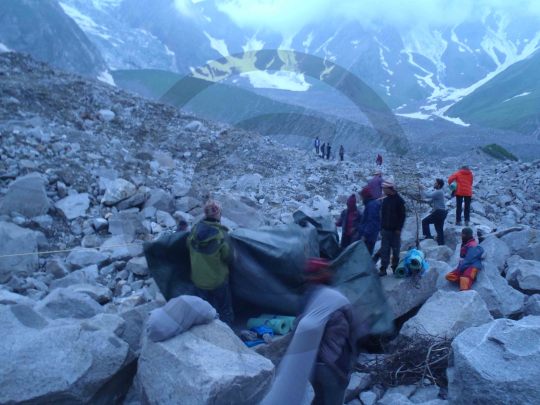
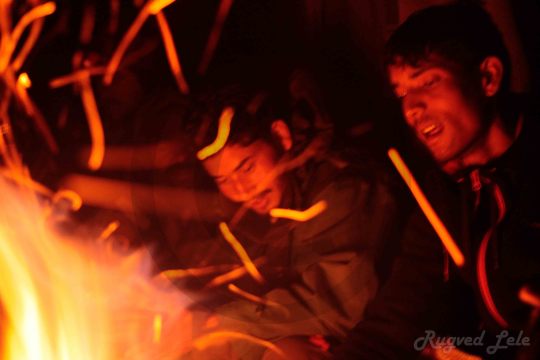
Survival is also an important activity that a mountaineer must go through. For Survival Night, trainees will have to spend an entire night outside their tents in natural environment with bare minimum resources. Before the activity, Instructors will be given tarpaulin, ropes and bamboos for making tents. Trainees will be given a certain boundary within which they will have to spend the entire night, and it will be away from the base camp. The Ropes would then be divided accordingly, where two Rope members will have to share the same tents, or a group of 5 - 10 trainees will have to search for a place in the assigned area to spend the night. Trainees will be allowed to carry their sleeping bag inner, windproof jacket, water bottle, torch and personal medications if any. Trainees will not be provided with dinner that day.
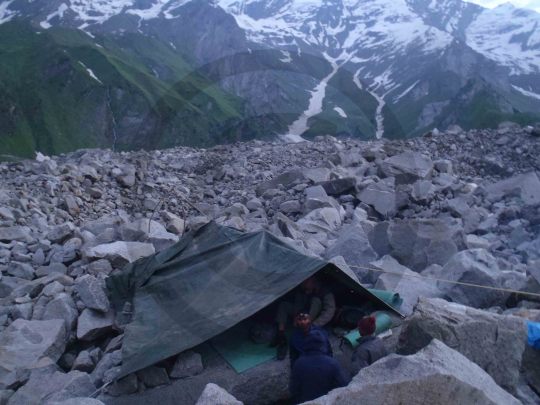
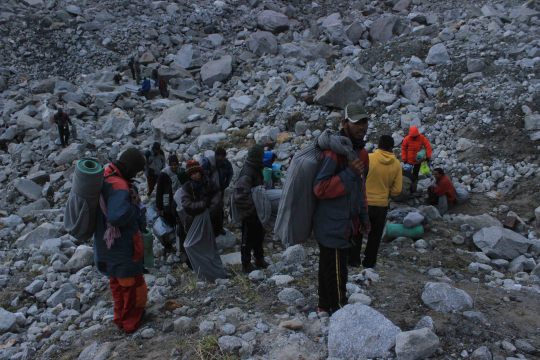
Trainees will have to search for appropriate place to spend the night. Trainees are allowed to collect wood / log for camp fire, go to the rivulet to fill their water bottles. Once a place is decided, trainees will have to Instructors where they will be spending the night. They will have to clean the place if necessary, make arrangements for sleeping by spreading the sleeping mats, make camp fire and then spend the entire night. Instructors will come for inspections during the night. Trainees are supposed to return to the base camp the next morning only after a certain time that would be given to them by the Instructors.
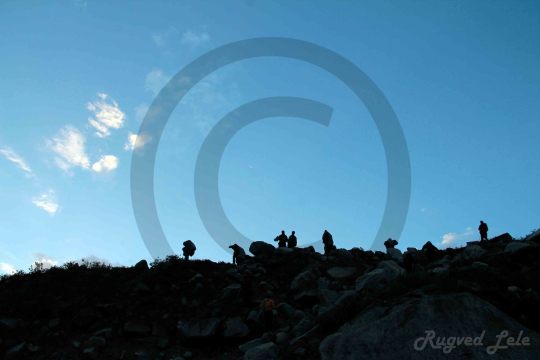
(Day 25 - Day 26)
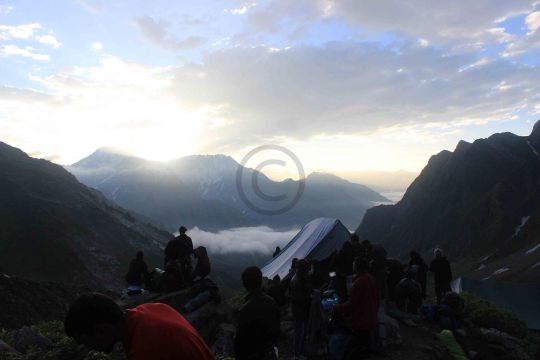
After the trainees return to their tents, they will have to pack their rucksack with the remaining things taken for survival night, clean their tents, and dismantle the entire tent. Post breakfast, trainees will be made to clean the entire base camp before departing towards Solang Nalla. Trainees will then trek towards Solang Nalla and spend a night at the Skiing Institute. The day after, they will trek towards Manali and reach the Institute.
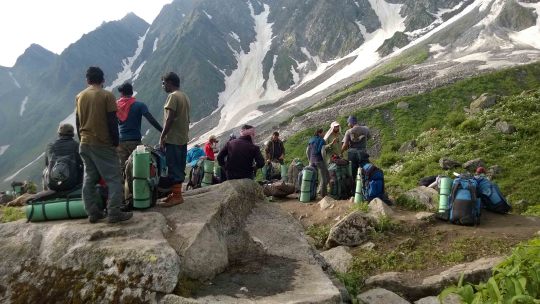
The training comes to an end after reaching Manali, with only the written test remaining. Trainees will have to return all their equipment on that evening, or after the written test.
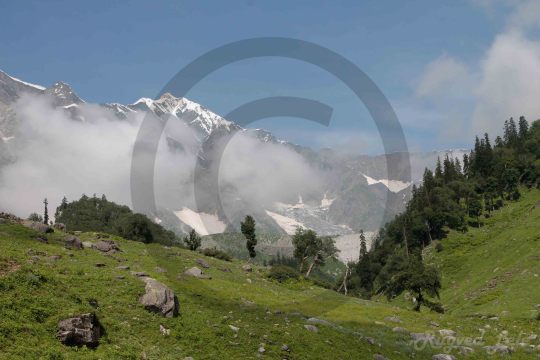
i. Theory, Written Test & Passing Out Parade:
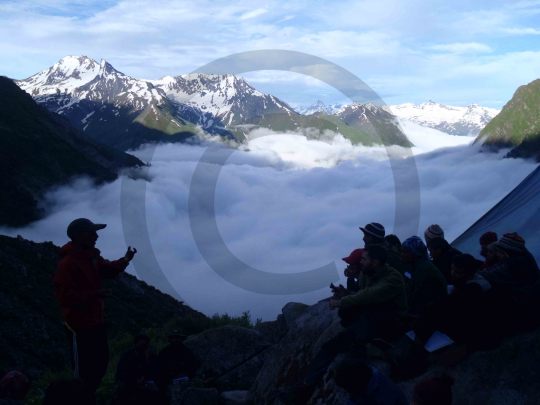
Theory sessions are very important to learn the theoretical part of mountaineering. Theory sessions will be conducted in the afternoon post lunch. These theory sessions would be based on Ropes, Knots, First Aid, Himalayas, Mountain Weather, Mountain Hazards, Avalanche, Map Reading, Mountaineering Terms, Glacier, Mountain Manners, Equipment, Camp Hygiene, etc. There will also be practical sessions on Rucksack packing, Tent pitching, Avalanche Beacon, Compass Reading, etc.
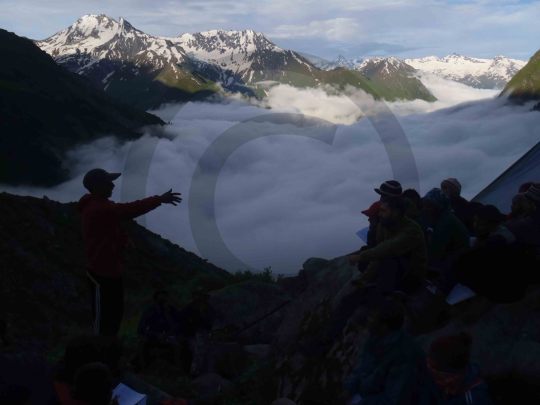
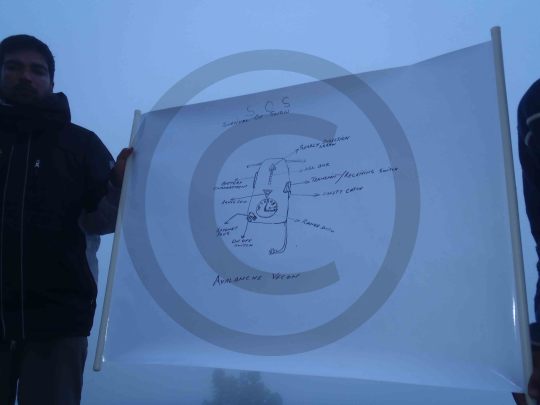
Mountain Terminologies are very important and these terms define various features of the mountains. Instructors will teach and also show as many features as they can while training or while trekking to training areas. There are many features visible from the base camp and it becomes very easier to understand the features that can be useful for future expeditions.
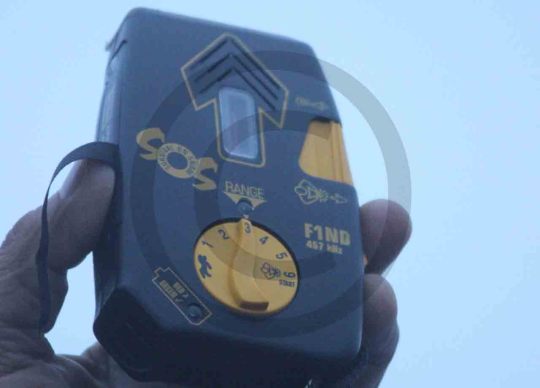
(Day 27)
Written Test is an examination to evaluate a trainee based on the entire theory lectures and notes that have been dictated throughout the course. The test is of 25 Marks and has questions based on terminology, General Knowledge and other theory questions. The test will be of 1 Hour. After the written test, the trainees will be interviewed by a Senior Director or Instructor. The interview will be taken Rope-wise.
(Day 28)
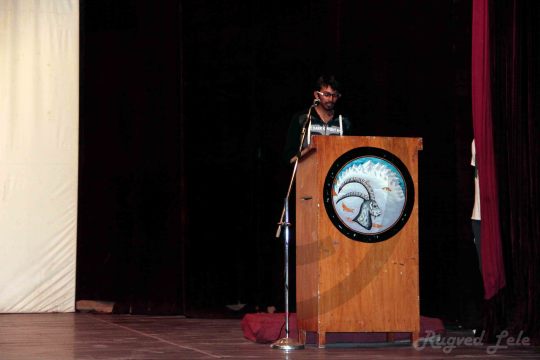
The Passing Out Parade is the ceremony to felicitate the trainees for successful completion of the course. In this ceremony, the trainees will be given badges for completion of AMC, awards for Best Trainee, Best Rope and Clean Himalaya. There will also be a cultural show where trainees can give dance, singing, acting or any such sort of performance. After the ceremony, there will be a grand lunch. Post lunch, a trainee must collect the Movement Order in order to move out of the Institute.
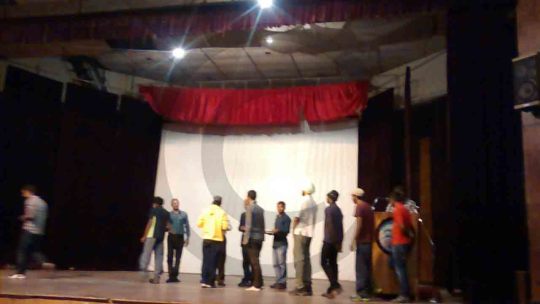
Trainees will be evaluated everyday for their performance, confidence, behaviour, interactions, attitude, project work and will be given marks accordingly. The entire course is of 400 Marks of which 300 Marks are equally divided among the 3 crafts. To secure 'A' Grade a trainee must secure 70% or more (280+ Marks) and then only is eligible for Methods of Instructions Course.
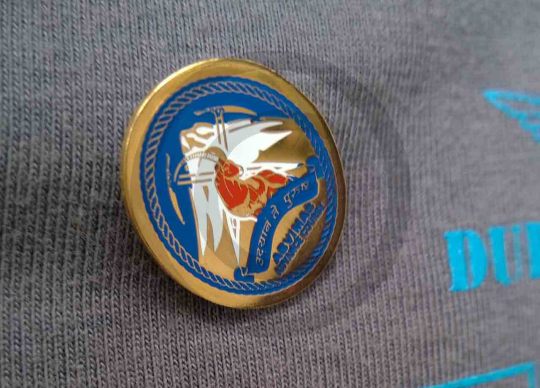
j. Expedition Project:
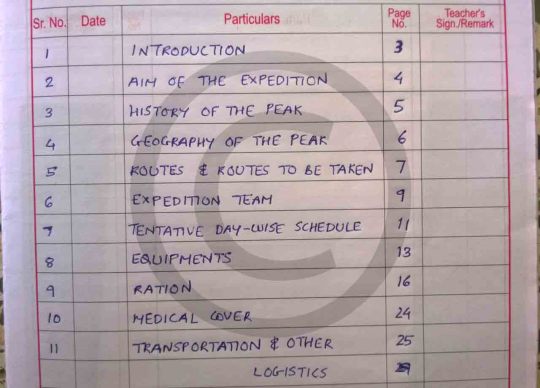
Expedition Project is an very important activity for any mountaineer as it helps to properly lay out plans for successful expeditions. In AMC, trainees will be introduced to making a complete Expedition Project so that they have an idea how to plan for future expeditions. On the 1st or 2nd day, the trainees will be given proper guidelines for making the entire Expedition Project to a particular peak assigned to them. The Instructors will explain all the main points that have to covered, what details have to filled in, and then solve doubts, if any.
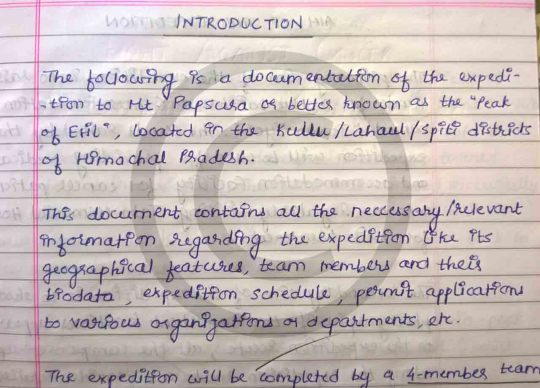
In Expedition Project, the main points that are to be covered are:
Introduction & Aim of the Project
History & Geography of the Peak
Routes & Routes to be Taken
Expedition Team
Tentative Day-wise Schedule
Equipment & Ration
Medical Cover, Transportation & Other Logistics
Applications to various Organizations & Local Bodies
Sponsors & Acknowledgement
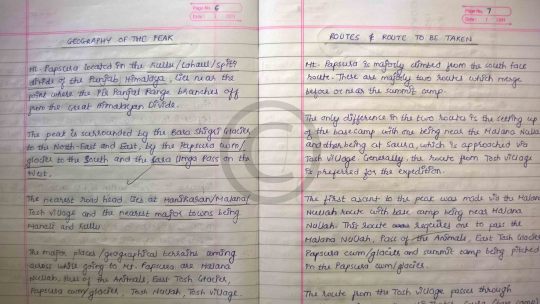
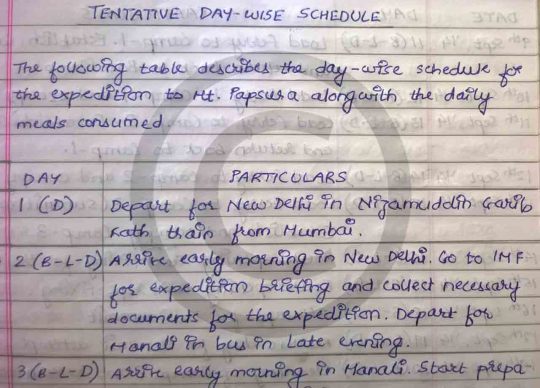
The trainees will be assigned a peak at random and will be given reference material for the peak. Trainees will have to make a detailed report on the above mentioned points. The project work will be during the span of Rock Craft and trainees will have to utilize the spare time to complete the project. Trainees will have to submit the project before leaving for higher camp.
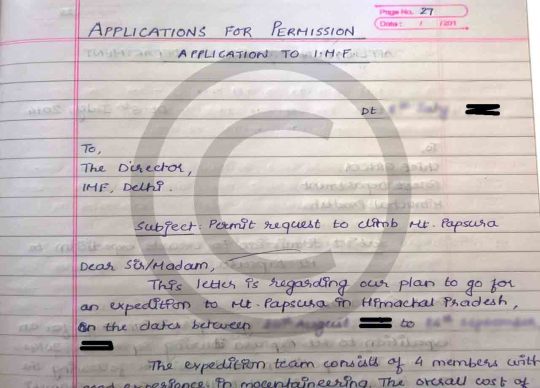
k. AMC Dates & Fees:
AMC is conducted from 30th - 26th of May-June, 29th - 26th of June-July and 30th - 26th of August-September months. The fees for Indian Nationals is ₹ 18480 / ₹ 20328 (July Batch) and ₹ 61600 / ₹ 67760 (July Batch) for Foreign Nationals.
#abvimas#mountaineering#mountaineeringcourse#himachalpradesh#himachal pradesh#manali#manalidiaries#rockclimbing#rock climbing#snow climbing#ice climbing#solangvalley#beas kund trek#rappelling#mountainclimbing#adventure travel#mountaineering courses in india#himalayas#advancemountaineeringcourse#himachalgram
2 notes
·
View notes
Text
Trek to Everest Base Camp
The trek to Everest Base Camp trek is a tea house trek. There is no other place on the planet where you can go trekking like Nepal. Villages dot the landscape, each with its own set of hotels, restaurants, and tea houses (mini-hotels) where you can stop for lunch, buy supplies, and eat apple pie. You do not stay in tents on the EBC Trek. You stay in teahouses with comfortable beds, wood-burning fireplaces, and restaurants. They are a welcome sight after a long day of trekking, contributing to the trek to Everest being one of our most memorable experiences.
Trek to Everest Base Camp
How is the trek to Everest Base Camp in Nepal? It's life-changing, exhilarating, and challenging. In this step-by-step EBC trek guide, we cover everything you need to know, from planning to packing for your trip to breaking down each day. So relax and join us on a journey through Nepal's legendary Sagarmatha National Park.
Itinerary for Everest Base Camp
On the map, the distances between villages on the everest base camp trek cost appear to be relatively short. Eight days appears to be more than enough time to cover a mere 63 km (39 miles) (one way), but with several days above 4000 metres in a row, the walk is slow and steady. To avoid altitude sickness, it is critical not to push too hard. Expect to hike between 7 and 17 kilometres per day.
Since 1976, Sagarmatha National Park has been designated as a UNESCO World Heritage Site. It is one of the most beautiful places we have ever visited, covering 1148 square kilometres (443 square miles). Plan your trek to Everest Base Camp now.
Start Kathmandu – Flight To Lukla
Flight from Kathmandu to Everest Base Camp
Our journey began in Kathmandu, Nepal, where we spent a few days gathering all of the necessary equipment and booking a tour with a local company. We chose Simreak Real Nepal, which is owned by Kathmandu resident Dipendra Simkhada. He organised the entire trip for us, and all we had to do was wait for him to pick us up at our Kathmandu guesthouse and take us to the airport to board our Tara Air flight to Lukla.
Getting into Sagarmatha National Park
Sagarmatha National Park trek to Everest Base Camp
Because mount everest base camp trek is located in Sagarmatha National Park, a permit is required to hike there. Dipendra took care of everything after we checked in at the national park headquarters. He had everything in order, so all we had to do was start walking.
We were ecstatic as we walked through the welcome gates just outside of Lukla. This was it; we were following in the footsteps of our era's great adventurers. Hiking through the Khumbu region while surrounded by the Himalayas was breathtaking.
Everest Base Camp Accommodation - Tea Houses
We spent the rest of the day following the Dudh Koshi River Valley to the village of Pakding at a steady but leisurely pace. The weather was warm, and the first day of trekking was pleasant. We arrived at our first night on the trek after about 5 hours and spent the night in a comfortable teahouse.
It was a cute little hotel/teahouse that resembled a cottage. The wood-burning stove smelled delicious as it warmed the restaurant while our meals were being prepared. The rooms were spotless, and we slept soundly in our thick down sleeping bags.
Laka glacier trek, Friendship peak trek, Bhrigu lake trek, Beas kund trek, Hampta pass trek, Sar pass trek, Kashmir great lakes trek, Everest base camp trek, Rupin pass terk, Roopkund trek, Pangarchulla peak, Valley of flowers trek, Har ki dun trek, Bali Pass Trek, Kasol tosh kheerganga trek, kasol kheerganga trek, Triund trek, kheerganga trek, Triund trek, Chadar trek ladakh, Kuari pass trek, Dayara bugyal trek, Chopta trek, Kedarkantha trek, Brahmatal trek, Kasol trek, Kasol tosh trek,
0 notes
Text
Fa – Konda Climbing Expedition – Adventure Academy
This is a very challenging & scenic, summer high-altitude Mountaineering Expedition cum Trek. Starting from the Prini roadhead, the trek winds through lush green valleys, moraines, high-altitude meadows and dazzling landscapes. Once atop the Fa – Konda pinnacle peak (Trig Height) (4250m), another spectacular panorama of peaks appears stark Beas Kund valley. The snow capped mountain valley view from Fa - Konda trig height is a photographer’s delight. You also see some good mountain peaks and a number of dazzling mountain massif on this Himalayan Camp.

Mountaineering:
A hobby that cultivates the spirit of adventure, endurance, determination, co-living and love for nature… All these positive aspects of individual’s personality nourished and cultivated by mountaineering are directly resulting into National character building.
What is Mountaineering?
Mountaineering, otherwise known as Alpinism in Europe, is the sport, profession, or recreation of Climbing or going up mountains. It is a more challenging form of hiking; where one have to trek on higher altitudes. Although the toughest, this adventure camp is also the most fulfilling.
MOUNTAINEERING IN INDIA
The Himalaya, Karakoram and Hindu Kush ranges extend from Namcha Barwa in the east to the borders of Afghanistan in the west. Political maps show them as parts of India, Bhutan, Nepal, Pakistan and Afghanistan. A very large section of the Himalaya and an eastern section of the Karakoram are in India. Broadly the Indian Himalaya consists of Arunachal, Sikkim, Uttarakhand, Himachal, Jammu & Kashmir and Eastern Karakoram. Though there are no 8000 m peaks in India except the Kanchenjunga, there are several peaks which are above 7000 m and a few of them are still unclimbed. A large number of peaks between 6000 to 7000 m are challenging and still virgin. Mountaineers in India have plenty of scope for exploration and conquest.
Himachal Himalaya
Kullu:
The lovely dales of Kullu have been a major attraction area for those who prefer to climb difficult but low peaks. The south Parvati area has peaks like Dibibokari, Pyramid, Papsura and Peak 20,101 (6127 m). This area too, is open to all climbers with peaks like Mukarbeh and Indrasan (6221 m), and has a lot to offer hobbyists and serious climbers alike.
Trek Itinerary:
REGION COVERED: Fa -Konda, Hamta Area. Via Tilgan-Jhamari, Pha-Konda and Manali.
Dates : 8th to 19th June 2019
MAX. ALTITUDE: 4450m.
NO.OF DAYS: 08 nights 09 days.
TRIP TYPE: Climbing, Trekking and camping.
LOCATION: Manali - Base camp at Shuru road head (3km from Manali).
REPORTING PLACE: At Base Camp at Shuru (Manali).
AGE GROUP: Above 15 years.
TREK GRADIENT: The trek in the beginning is a moderate walk up to a little hamlet called Thorku Dugh. The steepness in the trek increases gradually. On the ascend day, a little portion is tricky to negotiate and provides for a very challenging experience in a boulder covered snowy slope route. However, in general, it’s strenuous to an easy climb & trek.
Grading: A reasonable degree of physical fitness is needed for this trek.
Special interest: Excellent view for photographers, ideal place for nature lovers and an amazing place for adventure program lovers.
Get more details about Himalayan Camp from Nagpur at Adventure Academy
#adventure camps#himalayan camp#himalayan camp from nagpur#adventure programs#himalayan trek#adventure program
0 notes
Text
A Nice Beas Kund Itinerary from Solang Valley!
Where the mighty Beas River is born and adventure begins
Step into the world of the Beas Kund trek, where emerald meadows, rugged peaks, and the gurgling Beas River set the perfect stage for an unforgettable adventure.
From Solang Valley, this itinerary whisks you away on a magical journey to one of Himachal Pradesh’s most iconic trekking spots.
Let’s lace up those boots and dive into this unforgettable Himalayan experience!
Here’s Why Beas Kund Trek Should Be Your Next Adventure
The Beas Kund trek distance spans a rewarding 16 kilometres through pristine landscapes, leading you to an altitude of 12,772 feet where the Beas River springs to life.

This moderately challenging trek offers an ideal mix of adventure and tranquillity, perfect for both beginners and seasoned trekkers.
The Beas Kund trek best time to visit is from April to September, when the weather is pleasant and the trails are clear of snow, allowing you to fully immerse yourself in the vibrant flora and breathtaking views.
Over 2 nights and 3 days, you’ll disconnect from city life, note there’s no electricity at the campsites, and the last ATM is in Manali, making this trek a pure escape into nature’s embrace.
Beas Kund Trek Itinerary: Explore Nature’s Hidden Gem
Day 1: Manali to Dhundi & Trek to BakarThachBegin your journey with an 8 AM pickup from Manali, followed by a scenic drive to Dhundi. Trek for about 4 hours through lush meadows to reach BakarThach (3,300 m), where you’ll camp near the beautiful Beas Kund Glacier.
Day 2: Trek to Beas Kund & ReturnTrek to the serene Beas Kund lake at 12,772 ft, surrounded by majestic peaks like Deo Tibba and Indrasan. Take in the stunning views and the lake’s spiritual significance before returning to camp at BakarThach.
Day 3: Trek Back to ManaliDescend from BakarThach to Dhundi along the familiar trail. Then, drive back to Manali, concluding your memorable trek filled with breathtaking landscapes and unforgettable moments. Use the Beas Kund trek map to navigate each stage of this incredible adventure.
Important Things to Know for Your Beas Kund Trek
High-altitude climate requires proper acclimatisation; take adequate time to adjust.
Follow the trek guides’ instructions for a safe journey.
Avoid alcohol and intoxicants during the trek.
Trekking at night is discouraged unless guided.
Respect the eco-friendly zone: avoid littering and conserve water.
Minimise plastic use to protect the environment.
Camping is basic; electricity and charging points may be limited.
Carry dry snacks and refillable water bottles.
Keep luggage light for easier trekking.
Consult a physician before starting the trek; bring a first-aid kit.
Pack warm clothes and suitable trekking shoes.
Personal expenses and meals outside the package are not included.
The Beas Kund trek plan may change due to emergencies or weather conditions.
Follow government guidelines: social distancing, mask-wearing, and hygiene.
Professional guides and reliable transport are provided for safety and comfort.
Conclusion
The Beas Kund trek offers an unforgettable blend of natural beauty, adventure, and spiritual connection. By preparing well and respecting the guidelines, you’ll ensure a safe and rewarding experience.
Embrace the journey, soak in the stunning views, and create memories that will last a lifetime.
#beas kund river#beaskundtrek#beas kund trek#beas kund#beas river#beas#beas kund trek distance#beas kund trekking
0 notes
Text
Beas Kund Trek: The Perfect Adventure Awaits in 2024!

For those seeking an adventure in the lap of nature, the Beas Kund Trek offers an exhilarating experience filled with scenic beauty and challenging trails. Nestled in the heart of the majestic Himalayas, this trek is ideal for adventure enthusiasts, nature lovers, and photography aficionados.
With a distance of 16 KM, the Beas Kund Trek takes you through serene meadows, lush forests, and snow-capped peaks, making it a perfect escape from city life.
What is Beas Kund?
Beas Kund is a high-altitude alpine lake in the Himachal Pradesh region, believed to be the origin of the mighty Beas River. This small glacial lake is steeped in mythology and is said to be the meditation spot of the revered sage Vyas, the author of the Mahabharata. The trek to Beas Kund offers trekkers a glimpse of this significant historical and spiritual site, along with breathtaking views of the surrounding peaks such as Mt. Hanuman Tibba, Friendship Peak, and the Shitidhar.
What is the Distance and Route of the Beas Kund Trek?
The Beas Kund Trek distance is around 16 KM, starting from Solang Valley, a popular tourist destination near Manali. The route takes you through diverse landscapes, from green meadows of Dundi and Bakarthach to the rocky terrains leading up to Beas Kund. The journey offers uninterrupted views of pristine nature and is a moderate trek, suitable for both beginners and experienced trekkers.
Best Time to Visit Beas Kund Trek
Beas Kund Trek best time to visit is during the summer months, from May to mid-October. During this period, the snow melts, revealing the lush greenery and blooming flowers that make the trail even more picturesque.
The monsoon season, however, should be avoided as the trails can become slippery and dangerous. Temperatures during the trek vary between 10°C to 20°C, making it pleasant for trekking during the day and cooler at night.
Trek Highlights: Beas River and Map
The highlight of the trek is undoubtedly the sight of the Beas River, which flows gracefully alongside the trekking route. You can explore the river’s surroundings while enjoying the cool breeze and tranquillity of the place.

Essential Gear for a Successful Beas Kund Trek
Before setting out on the Beas Kund Trek, ensure you pack the necessary trekking gear, including:
Warm clothing, as the Beas temperature can drop sharply, especially at night.
Comfortable trekking shoes with a good grip for the rocky terrains.
Trekking poles, sunscreen, and a basic first aid kit.
A backpack with sufficient water, energy bars, and snacks.
A Journey Through Nature and Himalayan History
The Beas Kund Trek is not just an adventure; it’s an opportunity to immerse yourself in the beauty of nature and the rich history of the Himalayas. Whether you’re trekking solo or in a group, the serene surroundings, pristine river, and majestic mountain views promise a fulfilling and memorable experience in 2024. With the right preparation and timing, your trek to Beas Kund will be nothing short of extraordinary.
#Beas Kund Trek distance#Beas Kund Trek best time to visit#Beas kund#beas river map#beas temperature
0 notes
Photo
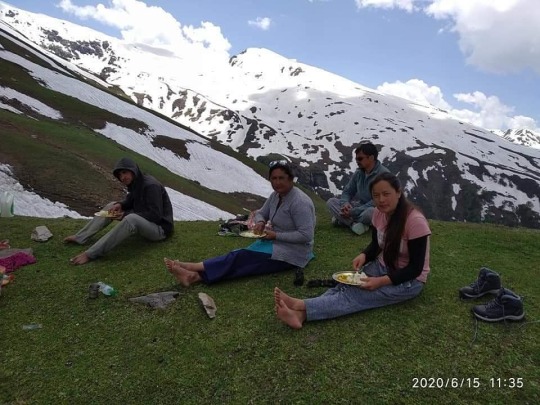
Patalsu Peak at 4200m (13,800 ft) is a moderately easy summit near Manali. The trail starts from Solang village, climbing through meadows and pine, deodar and oak forests inhabited by Monals and Pheasants among other fauna for two days to the summit. The campsites offer panoramic views of the entire Kullu valley and Hanuman Tibba, Friendship Peak, and Manali Peak. From the Patalsu summit, you can see a sea of snow covered mountains towering over the Kullu valley, and excellent views into Lahaul and Spiti. Along with traditional Kullu hospitality and signature Manali forests, the Patalsu trail offers amazing views of the Beas Kund peaks including Hanuman Tibba, to round up a perfect beginners summit! Stay on this page for more details - like Patalsu Peak trek route map, itinerary, temperature and weather info, photos and videos. DM for details or bookings @8591999333 . . . . . . . . . . #manali #himachal #himachalpradesh #shimla #kullu #india #himalayas #travel #himachali #mountains #nature #pahadi #himachaltourism #travelphotography #kangra #mandi #instahimachal #himachaldiaries #kinnaur #kasol #photography #chamba #love #solan #incredibleindia #manalidiaries #instagram #himachalpictures #travelgram #adventurehimalayas (at Patalsu Peak Trek Manali) https://www.instagram.com/p/CP5cF40JQEt/?utm_medium=tumblr
#manali#himachal#himachalpradesh#shimla#kullu#india#himalayas#travel#himachali#mountains#nature#pahadi#himachaltourism#travelphotography#kangra#mandi#instahimachal#himachaldiaries#kinnaur#kasol#photography#chamba#love#solan#incredibleindia#manalidiaries#instagram#himachalpictures#travelgram#adventurehimalayas
0 notes
Text
Beas Kund Manali: A Perfect Spot for Spiritual Seekers!

Nestled in the heart of Himachal Pradesh, Beas Kund Manali stands as a sanctuary for those seeking peace, adventure, and a spiritual retreat. With its captivating landscapes and rich spiritual history, this sacred lake offers an unforgettable experience for trekkers and nature lovers. Whether you’re exploring the Beas River Valley or reflecting by the shores of Beas Kund, the journey here is more than just a trek — it’s an invitation to connect with nature and the divine.
Exploring the Sacred Beas Kund Trek
The Beas Kund Trek is an enchanting journey that begins at Solang Valley, a picturesque spot located near Manali. As you ascend, you traverse through lush meadows, crossing Dhundhi and Bakarthach, before reaching the ultimate destination — Beas Kund. This sacred lake is considered the source of the Beas River, and the trek offers panoramic views of some of the highest peaks, including Hanuman Tibba, Friendship Peak, and the majestic Pir Panjal range. The allure of this trek lies in its combination of natural beauty and spiritual significance.
Beas Kund Trek Map: Your Guide to the Path
Before embarking on this incredible journey, it’s essential to have a good understanding of the Beas Kund trek map. The trail is relatively straightforward for experienced trekkers, but navigating the terrain with a detailed map ensures you don’t miss the stunning spots along the way. Starting from Solang Valley, you will hike through thick forests, cross several small streams, and witness panoramic views that will leave you awe-struck. Reaching Beas Kund at 3,810 meters, you are treated to a spiritual experience, where the lake’s serene waters reflect the surrounding peaks in perfect harmony.
The Beauty of Beas River Valley
The Beas River Valley is the lifeblood of the Beas Kund trek. Flowing gracefully through the Kullu region, the Beas River is integral to the local culture and ecosystem. As you trek along its banks, you are immersed in the beauty of the verdant valley, where wildlife sightings and nature’s symphony accompany you. The valley is also home to several scenic meadows and alpine forests, making it an ideal location for trekkers to explore. With every step, you get closer to understanding why this region holds such spiritual significance.
Beas Kund Temperature: What to Expect?
Understanding the Beas Kund temperature is crucial when preparing for your trek. Due to its high altitude, temperatures at Beas Kund can vary significantly. In the summer months, temperatures range from 10°C to 20°C, offering a pleasant trekking experience. However, during the winter, temperatures can drop significantly, with snowfall making the landscape even more magical. For trekkers, it’s important to pack appropriately, as the weather can change rapidly. A good mix of warm and light clothing is recommended, along with waterproof gear to tackle the unpredictable mountain weather.
Spiritual Significance of Beas Kund
As you make your way to Beas Manali, it’s impossible to ignore the spiritual aura that surrounds the place. According to local legend, Sage Vyasa, the revered sage of the Mahabharata, bathed in these very waters. This makes Beas Kund not just a beautiful location, but also an important pilgrimage spot for those seeking spiritual solace. The sacredness of the site draws spiritual seekers from across the country, creating a serene atmosphere perfect for introspection and meditation.
Beas Kund Manali: A Trekkers’ Haven
For those looking to embark on a spiritual trek, Beas Kund Manali offers the ideal destination. The combination of adventure, spirituality, and natural beauty makes it a must-visit spot for trekkers and nature enthusiasts alike. The breathtaking views, historical significance, and serene environment all contribute to the unique charm of this trek. Whether you’re looking to escape the chaos of daily life or seeking a deeper connection with nature, Beas Kund is the perfect spot to reflect, rejuvenate, and experience the beauty of the Himalayas.
0 notes
Text
TOP 11 ADVENTURE THINGS to do Himachal Pradesh Tourism Places
TOP 11 ADVENTURE THINGS to do Himachal Pradesh Tourism Places
For sheer geographical diversity, few places in the world are as richly endowed as Himachal Pradesh, Low rolling hi or climb on to touch the core of the Himalayan mountains. Here lie peaks that are several thousand metres high and never lose their perennial snow, past these, forbidding heights, lie the visually stunning cold desert of the Trans Himalaya Rivers howling through deep gorges and placid mountain lakes, thick forests and acres of green mountainsides draped with snow and green Alpine all form a part of this immense spectrum. The possibilities for a whole range of adventure activities are also enormous, There are day hikes by the thousands, and the trek routes follow trails that last a couple of days or can extend over a few weeks.
There is skiing. heliskiing and ice-skating. There is the thrill of paragliding and the test of stamina with mountain-cyc You can go camping and fishing and play golf or take a safari by car, jeep or on a motorcycle.
There are mountaineering and rock climbing. All you need is a reasonable level of fitness. Equipment, training and instructors are available. And then, All this comes at a fraction of what it would cost you elsewhere in the world. Sedentary or strenuous, for the expert or beginner, Himachal Pradesh has a niche of adventure for everyone.
Himachal Pradesh Tourism Places
1.Golf At Naldehra Himachal Pradesh Tourism: just 23 km's away with a beautiful view. beyond Shimla is one of the oldest golf courses in India. Named after the daughter of Lord Curzon, the British Viceroy of India, it is a par 68,9 hole course Annandale, in Shimla has a 9 hole course. There is another at the exquisite glade of Khajjiar 22 km's from Dalhousie and 24kms. from Chamba.
2.Kheer Ganga Trekking Himachal Pradesh Tourism: The main trekking areas in HP are the Dhauladhar and Pir Panjal ranges between Shimla and Kullu Valley. There are also treks out of Kullu and in the Trans-Himalayan regions of Kinnaur, Lahaul and Spiti. Most trekking areas are between 1500- 6000 mt's. With well over 270 defined trails, the variation in terrain is enormous low scrublands, paths through paddy fields, trails strewn with pine needles, woods of oaks and flowering rhododendron, forests of Himalayan cedar & deodar all dotted with small pastoral hamlets, an old Forest dak bungalows' and SEB and PWD rest houses. Training facilities accommodation is are available a Manali Mountaineering Institute and also at centres of Dharamsala and Bharmour with agencies conducting treks and providing guides, equipment, porters, pack animals and maps Indeed, trekking through can prove to be a nice way of seeing the wonder of Himachal Pradesh. A must visit place kheer Ganga trekking.
3.Heli skiing Manali Himachal Pradesh Tourism: Heli skiing in Manali For high mountain thrills perhaps nothing can surpass the magic of heli-skiing. Under a deep blue sky, you are carried by helicopter to a snow-draped peak. It is a thrilling experience as you rapidly zoom down the slopes and realising that there is nothing except the sky and the snow when icy winds slap your face. It is available in the area found by the Hanuman Tibba, Rohtang Pan, Deo Tibba and Chanderkhani Pass near the resort town of Manali.
4.Kufri skiing Himachal Pradesh Tourism: one of the oldest, near Shimla the Mahasu ridge; the Markhanda ranges 64 kms. from Shimla with a beginners run, an advanced slope and a slalom run and also offering ski courses instruction and equipment on hire; the Directorate of Mountaineering and Allied Sports at Manali offers a variety of courses; the winter and summer skiing in the Solang area near Manali are a few among them.
Camping is the best way to enjoy the wonders of nature with your own gear or opting for any of the several camps offering accommodation, hikes, fishing, catering, nature tours and rafting. at Sarchu in Himachal Tourism has camps Kinnaur, Lahaul, tents at Sangla and Kalpa in and at Kazain Spiti. of India The Youth Hostel Accommodation run camps at Dalhousie, Kullu-Manali; private sector run camps at Baspa Sangla valley, at Kalpa in Kinnaur, at Tabo in Spiti, at Al Hilal Taragarh and Dharamsala in Kangra, at Shoja near Kullu, and at Mashobra and baldeyan near Shimla. Ice-skating The Shimla
5.Shimla Ice Skating Himachal Pradesh Tourism: The Shimla ice-skating rink has the largest open air area with naturally frozen ice in this part of the world. It normally begins in early December and carries on to February. Clear skies and low temperatures provide two sessions with every day, morning and evening. Memberships are available for the seasons, shorter terms and even for single sessions. Fancy dress carnivals gymkhanas ice hockey and dances enliven every season.
6.Bir Billing Paragliding Himachal Pradesh Tourism: This sport is a mix of skydiving and hang gliding and is perhaps the closest man has ever come to sailing the skies as free as a bird. The bald peak of Billing, above the Buddhist monastery of Bir in Kangra, Buddha Dhar near Bilaspur, in the Kullu Valley and Intkali in the Pabbar Valley near Rohra are places where para-gliding is done regularly. The Adventure Sports Hostel at Dharamsala and an Aero Sports Complex at Bir billing paragliding provide training and conduct events.
7.Mahseer Angling Himachal Pradesh Tourism: paradise for fishing in Himachal. Himachal Fishing has several sports for both trout and mahseer as well as other fishes.The best sports fishes both Brown and Rainbow Trout are found in the stream of Himachal. Upstream of Rohru in Pabbar Valley, Chirgaon, Seema, Mandil, Sandasu, Tikri, Dhamvari all within 5 to 25 km's, from Rohru, Kinnaur's Baspa river in the Sangla Valley, Uhl river near Barot-Luhandi, the Puran hatchery, Tikkar and Kamand, upper reaches of river Beas in the Kullu Valley and its tributaries like Sarvani, Parbati, Sainj, Hurla and Tirthan-The areas around, Patlikuhl, Katrain, Raison and Largi all are excellent for the sport.
The Kangra valley, reservoir Pong Dam, Nadaun along the river Beas, Chamba Pattan near garlic amar harsi pattan, and Lam Bagoan, and many more offer mahasar.Fishing fees are nominal. The trout fishing is from 31st March to 31st est months for mahasar are those that have an 'r' in their spelling-Jan, Feb, Mar, Apr, Sept, Oct. No and Dec.
8.Kangra Water and River Sports Himachal Pradesh Tourism: The Pong Dam Reservoir in Kangra in collaboration with the Directorate of Mountaineering and Allied Sports provide year-long activities like swimming, water-skiing, surfing, kayaking on the waters of the Gobind Sagar near Bilaspur, the Chamera Lake near Dalhousie and the Pandoh Lake on the Mandi-Kullu National Highway. white water river rafting is presently being hung on the Sutlej close to Shimla. The break game enjoys a reprieve amid winter and in parts of the storms.
9.Kinnaur Mountain Cycling Himachal Pradesh Tourism: Get yourself for high adventure with an expedition on cycles. The whole of Himachal is your playground. The visit can be combined with outdoors camping for several weeks. The lower level regions of the state-Kangra, Una, Hamirpur and Bilaspur-offer tender courses. or you can stretch your mind, muscle and stamina to reach out to the Trans-Himalayan tracts of Lahaul, Spiti and Kinnaur. For the lighter regions, the summer and autumn months are suggested.
10.Lahaul Vehicle Safaris Himachal Pradesh Tourism: You can explore the variety of Himachal Pradesh by jeep, car or motorcycle. By jeep, the Trans-Himalayan tracks can steadily unfold their natural and man-made wonders, cross the Rohtang pass, move through arid Lahaul to Leh and Ladakh or from Shimla-through picturesque Kinnaur, Kinnaur to Lahaul, haunting beauty landscape of Spiti drive over the Kunzam pass to enter Lahaul. All you have to do is buy a route map, plan your trip and are on your way.
11.Kheer ganga trekking Mountaineering and Rock Climbing Himachal Pradesh Tourism: The territory around Manali, directly frames the legend of mountaineering in Himachal Pradesh. The Chandra Bhag ranges, the Pir Panjal and Dhauladhar extents area specialists center.. The Beas Kund region and lower reaches of the Hanuman Tibba, the Manali and Skitidar peaks around the source of the river Beas and the Deo Tibba are suggested areas for beginners. The Chandra Bhag ranges, the Pir Panjal and Dhauladhar extents area specialists centre. The Manali Institute offers Courses.
#Himachal Pradesh Tourism Places#Himachal Pradesh Tourism#Mahseer Angling#Kufri skiing#Lahaul#Kinnaur#Rock Climbing#Bir Billing Paragliding#TOP 11 ADVENTURE THINGS to do Himachal Pradesh Tourism Places#Mountaineering and Rock Climbing#Vijaypandit#Vijay pandit#Shimla Ice Skating#Kinnaur Mountain Cycling#Mountaineering#Kangra#Kheer Ganga Trekking#Kheer ganga trekking#Kangra Water and River Sports#Kheerganga trek vijay pandit#Lahaul Vehicle Safaris
0 notes
Text
Beas Kund Trek: A 3-Day Itinerary from Solang Valley!

The Beas Kund Trek is a perfect blend of adventure and serenity, taking you to the sacred glacial lake of Beas Kund, believed to be the source of the mighty Beas River. Starting from the picturesque Solang Valley, this 3-day trek offers stunning views of the Pir Panjal range, lush meadows, and towering peaks. Whether you’re an avid trekker or a nature lover seeking tranquillity, this trek provides a rejuvenating escape into the heart of the Himalayas.
Let’s dive into the detailed itinerary to make the most of this remarkable journey.
Day 1: Journey to Dhundhi — Enter the Beas River Valley
The Beas Kund Trek begins at Solang Valley, a serene spot known for its scenic beauty and adventure activities. After a hearty breakfast, the trek to Dhundhi starts. The trail takes you through the lush forests of fir, oak, and walnut, with the occasional chirping of birds adding to the tranquil ambience. As you make your way to Dhundhi, you’ll traverse an 8 km stretch, climbing steadily to a height of 3,149 meters. This first day is all about soaking in the vibrant greenery and the rejuvenating sounds of nature. Upon reaching Dhundhi, unwind at the campsite and relish a warm dinner under the stars.
Trek Distance: 8 km Accommodation: Camping at Dhundhi Meals Provided: Breakfast, Lunch, Dinner
Day 2: Dhundhi to Beas Kund — Discover the Source of the Beas River
Wake up early to a refreshing breakfast before setting off for Beas Kund. The Beas Kund Trek distance from Dhundhi is about 8 km. As you ascend to an altitude of 3,893 meters, the landscape transforms dramatically. The dense forest gives way to alpine meadows and stunning views of the snow-clad peaks, including Deo Tibba and Indrasan. Upon reaching Beas Kund, you’ll witness the serene lake, considered the sacred source of the Beas River. The sight of this glacial lake, nestled amidst towering mountains, is a moment to cherish. After spending some time exploring and resting, the trek continues to Bakarthach, a beautiful meadow located at 3,270 meters. Enjoy the panoramic views and then head back to the Dhundhi campsite for the night.
Trek Distance: 16 km (Dhundhi to Beas Kund and back) Accommodation: Camping at Dhundhi Meals Provided: Breakfast, Lunch, Dinner
Day 3: Return to Solang Valley — Relive the Magic of the Beas River Map
On the final day, wake up to the crisp mountain air and a beautiful sunrise. After breakfast, the descent back to Solang Valley begins. The journey is around 8 km and offers a final chance to immerse yourself in the peaceful ambience of the Beas River Valley. As you descend, take a moment to reflect on the journey you’ve made, tracing the path of the Beas River on the mental map you’ve created. Upon reaching Solang Valley, you can indulge in some of the adventure activities the valley is famous for, such as paragliding or a cable car ride, before heading back home with memories that will last a lifetime.
Trek Distance: 8 km Meals Provided: Breakfast
Beas Kund Trek Package Details and Pricing
Package 1: Trekking from Solang Valley
Duration: 3 Days, 2 Nights
Cost: ₹ 4,499 per person
Inclusions: Meals on all trekking days, English and Hindi-speaking guides, trekking equipment, and safety gear.
Package 2: Trekking from Manali
Duration: 3 Days, 2 Nights
Cost: ₹ 5,499 per person
Inclusions: Meals on all trekking days, transportation from Manali to Solang and back, English and Hindi-speaking guides, trekking equipment, and safety gear.
Package 3: Wildlife Exploration Trekking from Delhi
Duration: 3 Days, 2 Nights
Cost: ₹ 6,999 per person
Inclusions: Transportation from Delhi to Manali and back, meals on all trekking days, English and Hindi-speaking guides, trekking equipment, and safety gear.
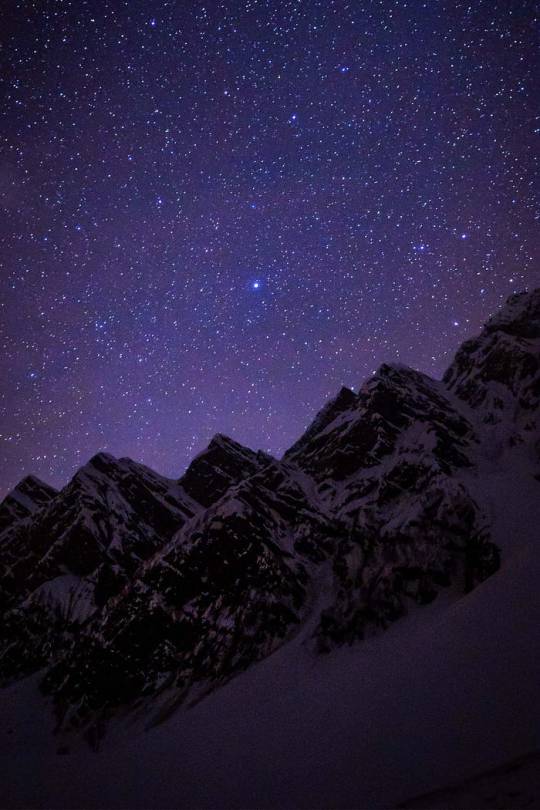
Best Time to Do Beas Kund Trek — When the Beauty Unfolds
The Beas Kund Trek best time to visit is from mid-May to mid-October. During these months, the weather is perfect for trekking, with clear skies and pleasant temperatures ranging between 10°C to 20°C. The snow melts by May, revealing the lush green meadows and the wildflowers are in full bloom, creating a vibrant canvas for trekkers. However, be prepared for sudden weather changes, as the mountains can be unpredictable. Carry layers and rain gear to stay comfortable throughout the trek.
Conclusion — An Unforgettable Adventure
The Beas Kund Trek offers a perfect blend of natural beauty, serene landscapes, and a touch of adventure. The journey through the Beas River Valley, past ancient glaciers and alpine meadows, is one of awe and inspiration. Whether you’re tracing the Beas River map mentally or gazing at the sacred lake of Beas Kund, this trek will leave you with stories to tell and memories to treasure.
0 notes